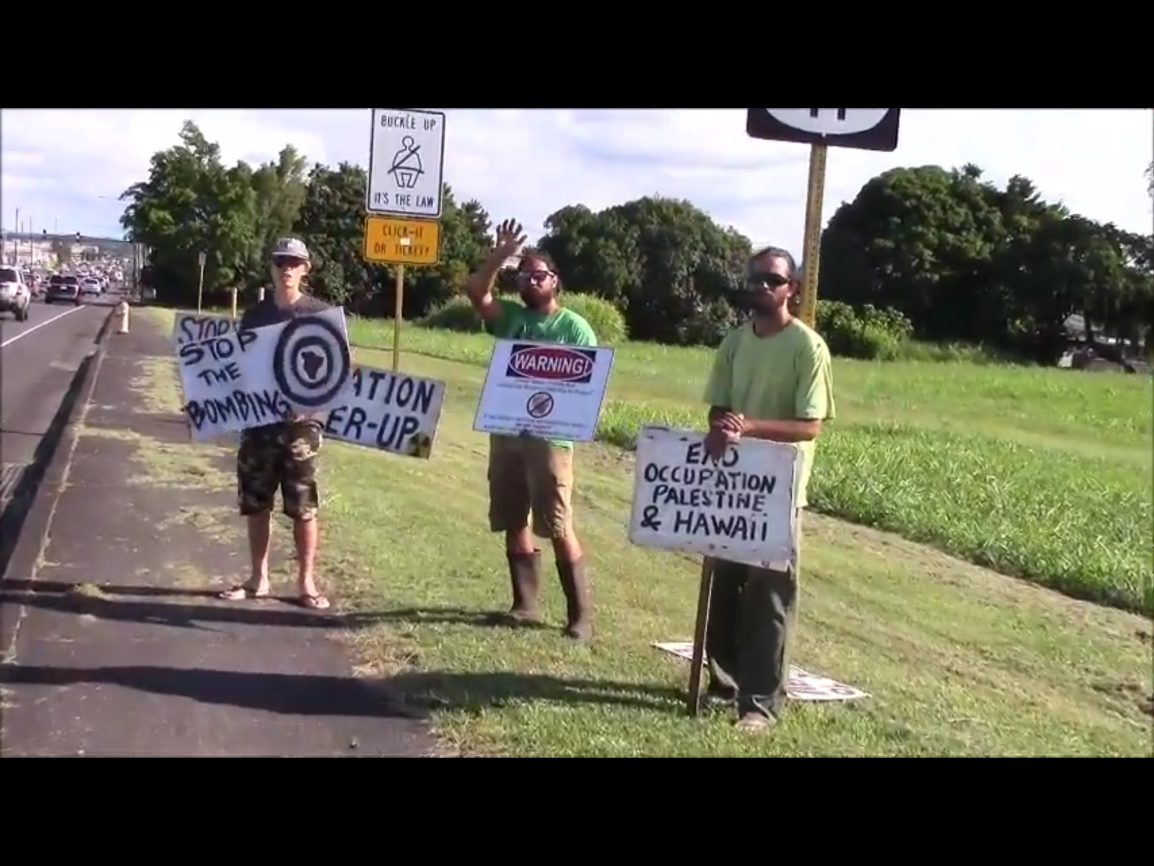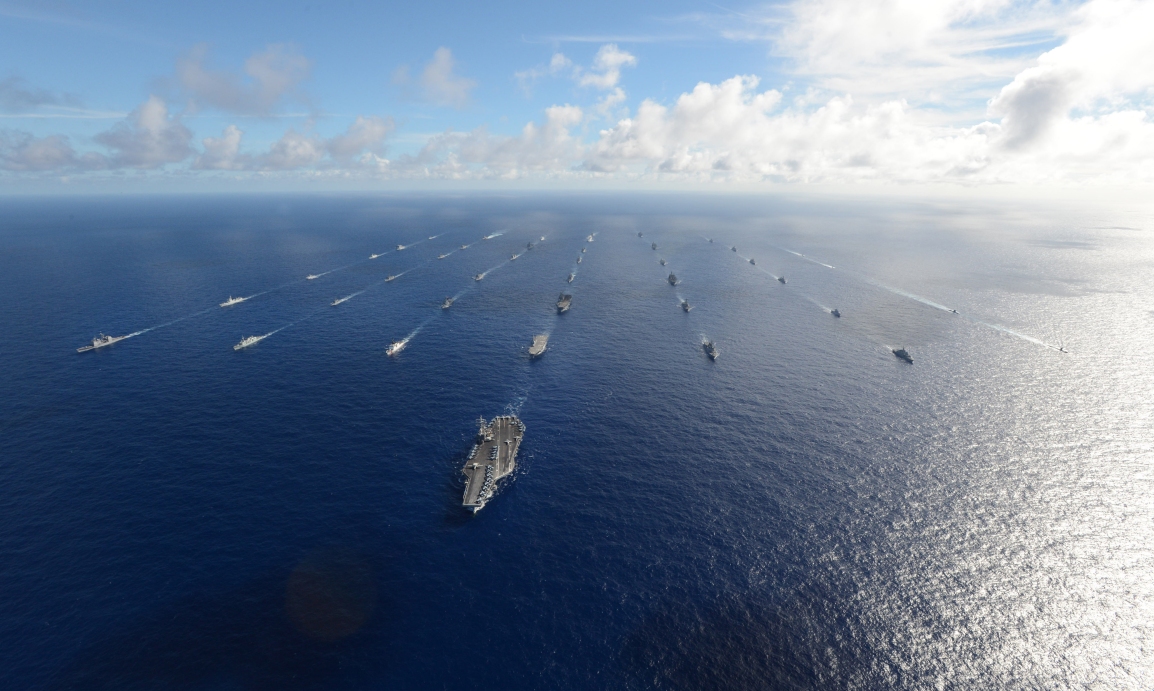
by David Uahikeaikalei‘ohu Maile
This talk was originally given at The Red Nation’s Native Liberation 2016 Conference at the Larry Casuse Center in Albuquerque, NM on August 13, 2016. David Uahikeaikalei‘ohu Maile is a lead organizer in The Red Nation.
Aloha mai kākou. ‘O David Uahikeaikalei‘ohu Maile ko‘u inoa piha. No Maunawili, O‘ahu mai ku‘u ‘ohana. ‘O Honolulu ka inoa o ko‘u one hānau. My name is David Uahikeaikalei‘ohu Maile. My family is from Maunawili on the island of O‘ahu, and Honolulu is the name of my birth sands. I am Kanaka Maoli (Native Hawaiian) and a lead organizer with The Red Nation. Building upon the brilliant work presented by my Native cousins and comrades, I will be discussing the military occupation of my ancestral home, Hawai‘i, in the context of the U.S. military’s Rim of the Pacific war games—otherwise known as RIMPAC—and Kanaka Maoli movements for de-militarization. I’ll begin by providing a historical background to demonstrate how Hawai‘i has been subjected to U.S. military occupation. Then, I’ll explain RIMPAC and some of its negative consequences. Finally, I’ll conclude by examining the ways in which Kānaka Maoli (Native Hawaiians) have organized to de-militarize Hawai‘i and for Native liberation.
To answer the question of how Hawai‘i and Kānaka Maoli are under U.S. military occupation, we must look to historical events that continue shape our present. In 1873, U.S. General John Schofield and Lieutenant Colonel Burton Alexander, in secret disguised as tourists, explored Hawai‘i for sites suitable to develop naval ports. What they discovered was ke awalau o Pu‘uloa—the many harbors of Pu‘uloa—which would later be called Pearl Harbor. In the spirit of former President John Tyler’s 1942 doctrine extending “Manifest Destiny” beyond the American continent, Schofield said, “[Pearl Harbor] is the key to the Central Pacific Ocean, it is the gem of these islands.” The Hawaiian islands became a precious location desired for the U.S. to expand trade into Asian markets, strengthen imperial power abroad, and exert colonial control over Indigenous peoples of the Pacific. For instance, in 1875, the Reciprocity Treaty was signed between the Hawaiian Kingdom and U.S., eventually granting the U.S. exclusive access to Pearl Harbor primarily for the trade of sugar, as it was a burgeoning and highly-profitable industry. This, in turn, prompted militarization of Hawai‘i in order to protect the global flow of U.S. capital and secure the building of its empire.
On July 6, 1887, King David Kalākaua, under threat of violence, signed the Bayonet Constitution, which bolstered the political powers of white, Euro-American men that would then go on to launch a coup d’état against Queen Lili‘uokalani and illegally overthrow the Hawaiian Kingdom on January 17, 1893. Importantly, this oligarchy of anti-Hawaiian white supremacists, shielded by their political party called the “Committee of Safety” but formerly known as the “Missionary Party” and “Annexation Club,” wielded support from the U.S. military. With the assistance of capitalists like Sanford Dole who’s family went on to found the corporate giant Dole Food Company, U.S. foreign minister John Stevens ordered the warship USS Boston to deploy more than 160 marines and sailors to join a paramilitary force, called the Honolulu Rifles, of approximately 1,500 in the service of installing a provisional government. Under resolute protest by the Queen and Kānaka Maoli, President Grover Cleveland launched an investigation in which commissioner James Blount reported, “United States diplomatic and military representatives had abused their authority and were responsible for the change in government.” President Cleveland thus declared, “The provisional government owes its existence to an armed invasion by the United States.” Famously, in his Report of the Committee on Foreign Relations, Cleveland exclaimed, “The military demonstration upon the soil of Honolulu was of itself an act of war.” As ethnic studies scholar Kyle Kajihiro has said, U.S. military occupation of Hawai‘i instantiated “regime change 1.0.”
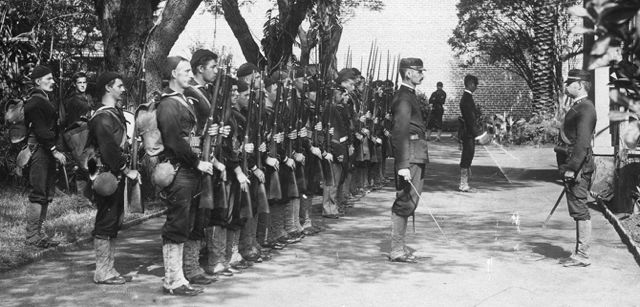
Despite vehment opposition to U.S. annexation by a majority of Kānaka Maoli, including my great-great grandparents C.B. Maile and Ko‘olau, a Joint Resolution of Congress, called the Newlands Resolution, was passed on July 6, 1898, incorporating Hawai‘i as a so-called territory of the U.S. This was largely fueled by President William McKinley’s aspiration to acquire a coaling station insofar as to transport military troops to the Philippines and fight in the Spanish-American War. “Hawai‘i served,” according to American studies scholar Vernadette Gonzalez, “as the American military’s first foothold in the Pacific.” Put differently, the military occupation of Hawai‘i beginning in the 19th century didn’t simply serve to marginalize my people and nation, but functioned also to transit U.S. empire elsewhere.
However, as I mentioned previously, the overthrow of the Hawaiian Kingdom was an illegal act. Kanaka Maoli scholars suggest the U.S. military-backed takeover was illegal according to U.S. constitutional and international law. For example, Williamson Chang argues an act of Congress, such as the Joint Resolution, doesn’t possess the power to annex a sovereign foreign country. Keanu Sai makes three different claims: there is no treaty of annexation, the so-called annexation violated international treaty rights, and Hawai‘i is under a belligerent military occupation. Even the U.S. federal government has admitted to these claims. In 1993, President Bill Clinton signed Public Law 103-150—the Apology Resolution—that “acknowledges the overthrow of the Kingdom of Hawai‘i occurred with the active participation of agents and citizens of the U.S. and further acknowledges that the Native Hawaiian people never directly relinquished to the U.S. their claim to their inherent sovereignty as a people over their national lands.” Thus, Hawai‘i isn’t the “50th state” of the union but, in fact, a clever legal myth normalized through the everyday practices U.S. militarism engenders and exports globally.
After the 19th century, U.S. military-industrial complex developed at an unprecedented rate upon stolen lands in occupied Hawai‘i. In the early 1900s, the U.S. military established infrastructure dedicated to coastal defense and infantry with Fort DeRussey, Fort Ruger, Fort Shafter, and also Schofield Barracks—named after General John Schofield who secretly surveyed Hawai‘i in 1873. In the 1930s, airfields were built at Bellows, Hickam, and Kāne‘ohe. After the Japanese bombing of Pearl Harbor on December 7, 1941, the U.S. tightened it’s military grip by instituting martial law, erecting concentration camps, and increasing recruitment of Japanese-Americans to be deployed in World War II. The Cold War subsequently ushered in more military expenditures to Hawai‘i, like the creation of the Barking Sands missile facility on the island of Kaua‘i. For the first time in the 1940s, U.S. military spending became the largest source of revenue in the islands.
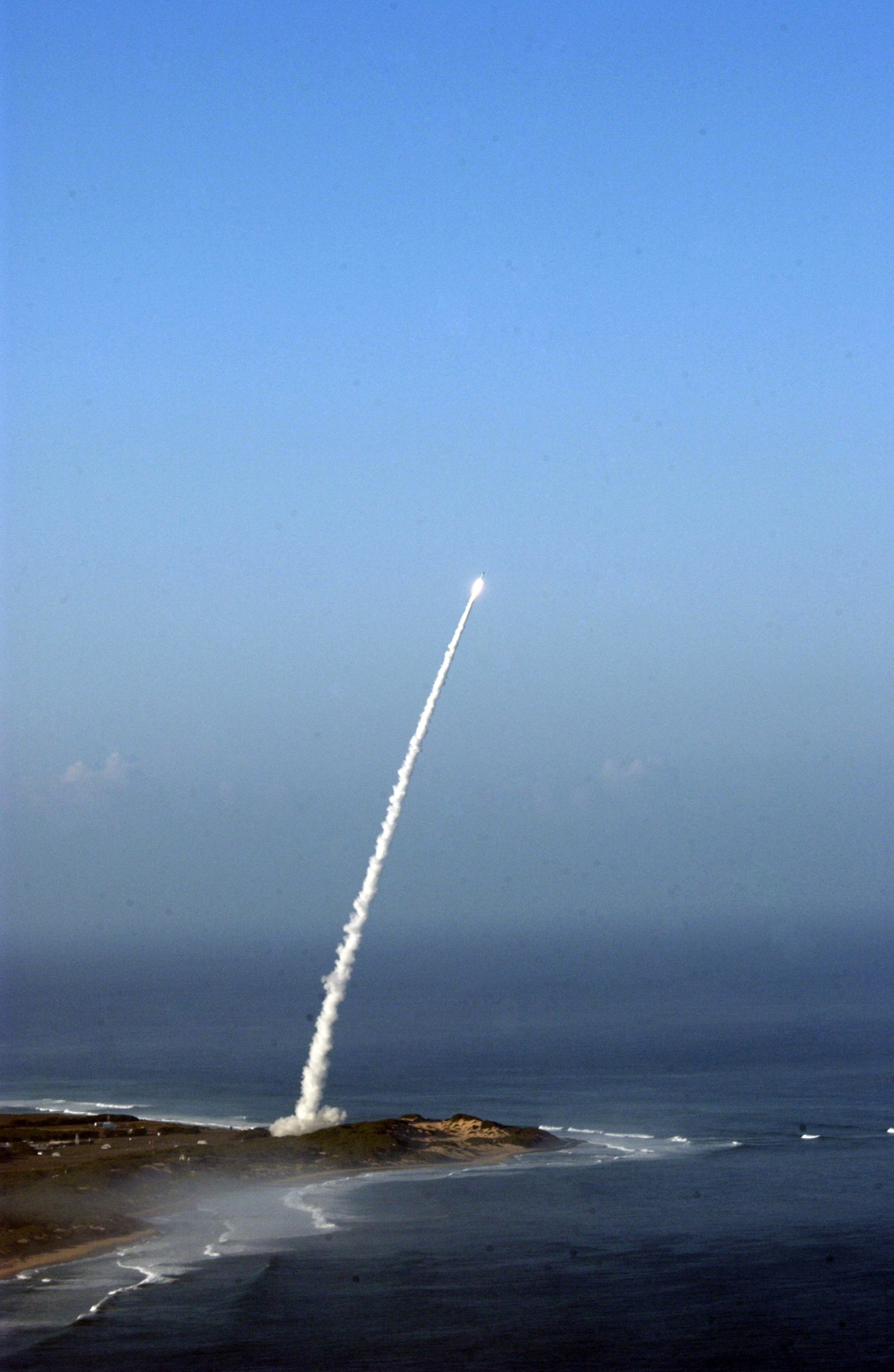
Reports from 2008 suggested, across the Hawaiian islands, the collective military forces of the U.S. maintained 21 installations, 26 housing complexes, eight training areas, and 19 bases and operating stations. Armed forces, military dependents, and veterans make up more than 16 percent of Hawai‘i’s entire population. Estimates from 2013 indicated the military controls more than 230,000 acres of land in Hawai‘i. On the island of O‘ahu, about 94,000 acres are controlled by the military, which makes up approximately 25 percent of the whole island. Recent reports show U.S. military spending in Hawai‘i was $8.8 billion in 2014, which ranked second only to the $14.7 billion tourists spent. As you can imagine, all of these numbers are likely higher now. This is especially true given the shift of military resources mandated under the Obama administration’s “Pacific Pivot” that has shored up “political cooperation” for the Trans-Pacific Partnership Agreement signed on February 4 of this year. But, the statistics nevertheless illustrate the intensity of Hawai‘i’s military occupation.
A key example of how the U.S. employs militarization to naturalize the illegal occupation of Hawai‘i is RIMPAC. Occurring once every two years in Hawai‘i and around its waters, the Rim of the Pacific, or RIMPAC, war games are hosted by the U.S. Pacific Fleet, which is a subordinate command of PACOM the U.S. Pacific Command. Headquartered in Hawai‘i, PACOM held 300,000 military personnel, which was about 20 percent of the total U.S. active-duty military force, in 2008. But, as their official website states, this number has increased to 360,000. Responsible for policing approximately half of the earth’s surface, PACOM’s mission is to “protect and defend, in concert with other U.S. Government agencies, the territory of the United States, its people, and its interests. With allies and partners, PACOM is committed to enhancing stability in the Asia-Pacific region by promoting security cooperation, encouraging peaceful development, responding to contingincies, deterring aggression, and when necessary, fighting to win.” Starting in 1971, RIMPAC is the world’s largest multinational maritime training exercise in which the U.S. Navy invites militaries to participate from nations all over the world. This year’s exercises concluded on August 4. In it, RIMPAC hosted 26 nations, more than 40 ships and submarines, more than 200 aircraft, and 25,000 personnel. These war games largely take place out of Pearl Harbor but also occur on land at sites such as Pōhakuloa, which is the largest training area, at 130,000 acres, outside the continental U.S. on Hawai‘i island near our sacred mountain Mauna a Wākea. It is as Kanaka Maoli scholar and activist Haunani-Kay Trask said, “The haole [foreign] war machine, including nuclear submarines and missiles, is well oiled and ready for deployment on a moment’s notice. Hawai‘i, like most of the Pacific, is a nuclearized paradise.”
There are many negative consequences caused by the RIMPAC war games. Some of the adverse impacts include the ongoing military occupation of ka lāhui Hawai‘i, or the Hawaiian Nation, the transit of U.S. empire, settler colonial dispossession and elimination of Indigenous peoples, desecration of sacred sites like ke awalau o Pu‘uloa and Pōhakuloa, the housing market’s increase in rental prices resulting from housing subsidies for military personnel, gendered and sexualized forms of violence, ecological degradation, and militourism, to only name a few. For the purposes of this talk I want to focus on one particular case of how RIMPAC excplicitly harms Hawai‘i’s environment.
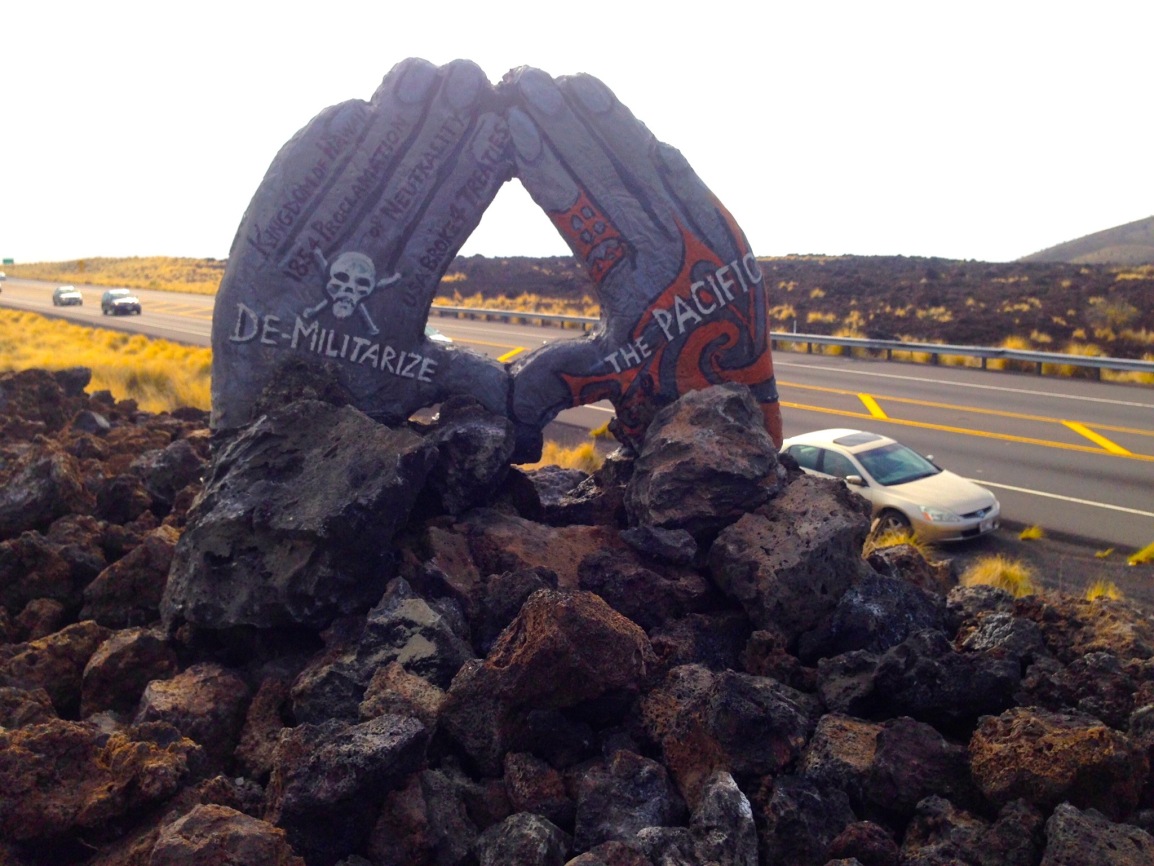
On April 31, 2015, federal judge Susan Mollway ruled, in a decision of the U.S. District Court, that the National Marine Fisheries Service illegally approved U.S. Navy testing and training activities for RIMPAC on the grounds it threatened widespread harm to whales, dolphins, and other marine mammals, in accordance with the Endangered Species Act and Marine Mammal Protection Act. It was concluded that the Navy’s use of sonar, explosives, and vessel strikes could cause permanent hearing loss, lung injuries, and death. An estimated 9.6 million instances of harm could come to marine mammals. Articulating evidence of its transgressions, executive director of Conservation Council for Hawai‘i Marjorie Zieglar said, “In 2004, Navy sonar during Rim of the Pacific war games was implicated in a mass stranding of around 200 melon-headed whales in Hanalei Bay on Kaua‘i, with one baby whale dying.” What this case, and its respective ruling, demonstrates is that U.S. military occupation of Hawai‘i, creating the conditions of possibility for and reproduced by RIMPAC, causes ecological genocide. Therefore, these environmental injustices, and others such as the contamination of Pōhakuloa with depleted uranium, must be read as inextricably linked to the militarization, illegal occupation, and settler colonization of Kānaka Maoli.
To end my talk, I want to map out some of the Kanaka Maoli led movements to de-militarize Hawai‘i. Historically, Kanaka Maoli anti-colonial struggles against U.S. annexation were also opposed to militarization. In 1889, Robert Wilcox, a Kanaka Maoli that was trained at the Royal Military Academy in Italy, organized a rebellion against the provisional government that illegal overthrew the Hawaiian Kingdom. Later on in 1895, Wilcox attempted a counter-revolution with Royalist Insurgents to take up arms and overthrow the then Republic of Hawai‘i. In 1890, a biography was written about Wilcox, celebrating him as a hero. In it, are two mele, or songs, that my great-great grandmother Ko‘olau authored—one called “He Inoa No Wilikoki” the other “He Puuwai Aloha Ko Wilikoki.” Together, they praise Wilcox as a revolutionary figure that defended the Hawaiian Kingdom. In another example, when the U.S. Army declared martial law in the islands in 1941, the island of Kaho‘olawe was appropriated and used to train troops, test weapons, and essentially as a bombing range. But, in 1976, the Protect Kaho‘olawe ‘Ohana filed suit in U.S. federal court to stop the bombing and organized efforts to re-occupy the island. These historic movements led by Kānaka Maoli have inspired contemporary organizing to de-militarize, de-occupy, and de-colonize Hawai‘i. Recently, Kānaka Maoli, and our allies, have organized public forums, sign waivings, social media campaigns, and petitions to stop RIMPAC, protect sacred sites, and de-militarize the Native Pacific.
The struggle against military occupation of Hawai‘i continues, but the historic and contemporary movements to de-militarize Hawai‘i, and the Native Pacific at large, are steadfast and unwaivering. It is a project for Native peoples’ collective liberation, and The Red Nation stands with Kānaka Maoli, now and in the future, against U.S. military occupation of Hawai‘i. If you stand against RIMPAC, military occupation of Hawai‘i, and settler colonialism of Indigenous peoples of the Pacific, please consider signing the petitions, first, to demand an environmental assessment of this year’s RIMPAC exercises and, second, to put an end to the RIMPAC war games once and for all.
